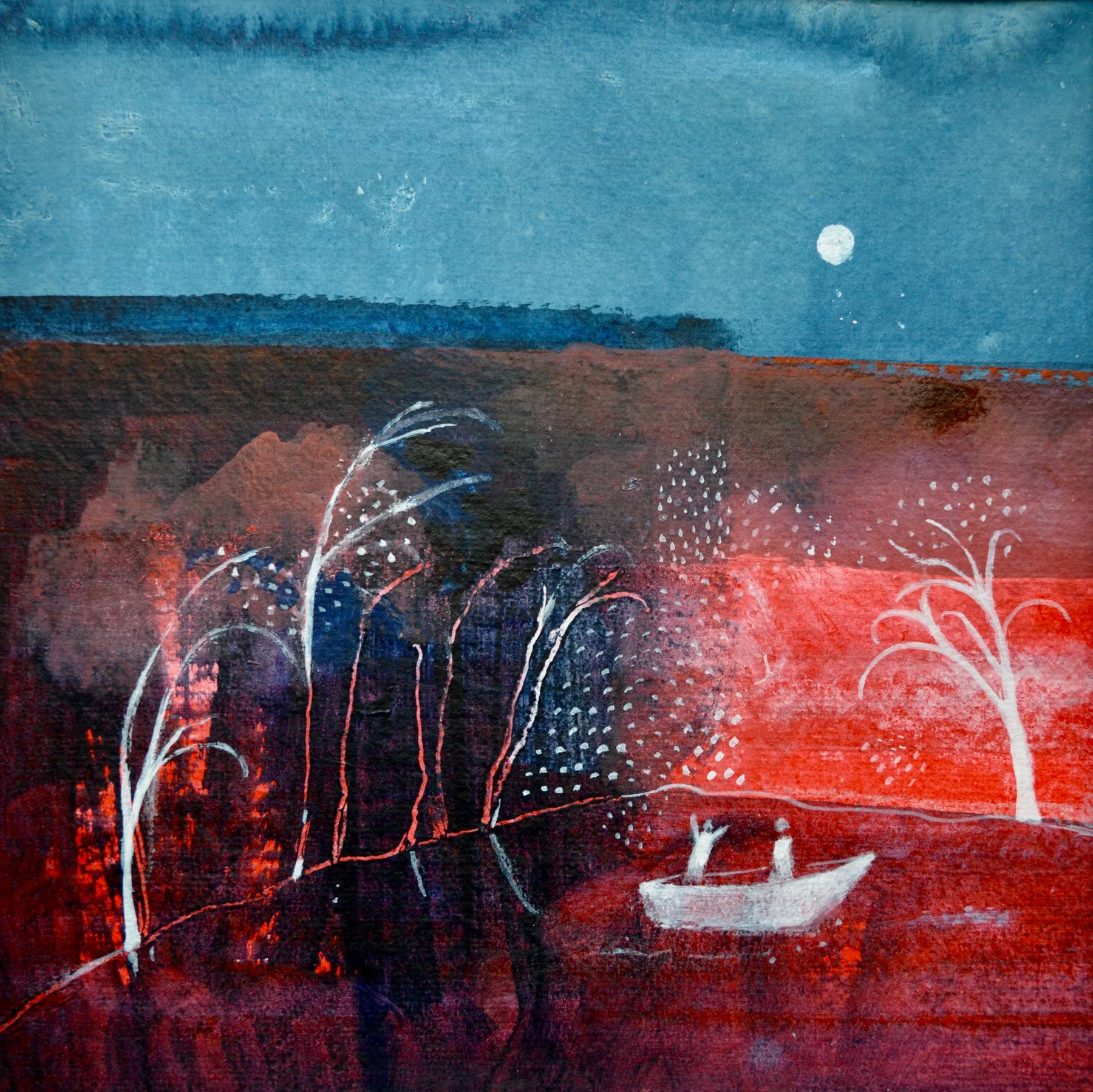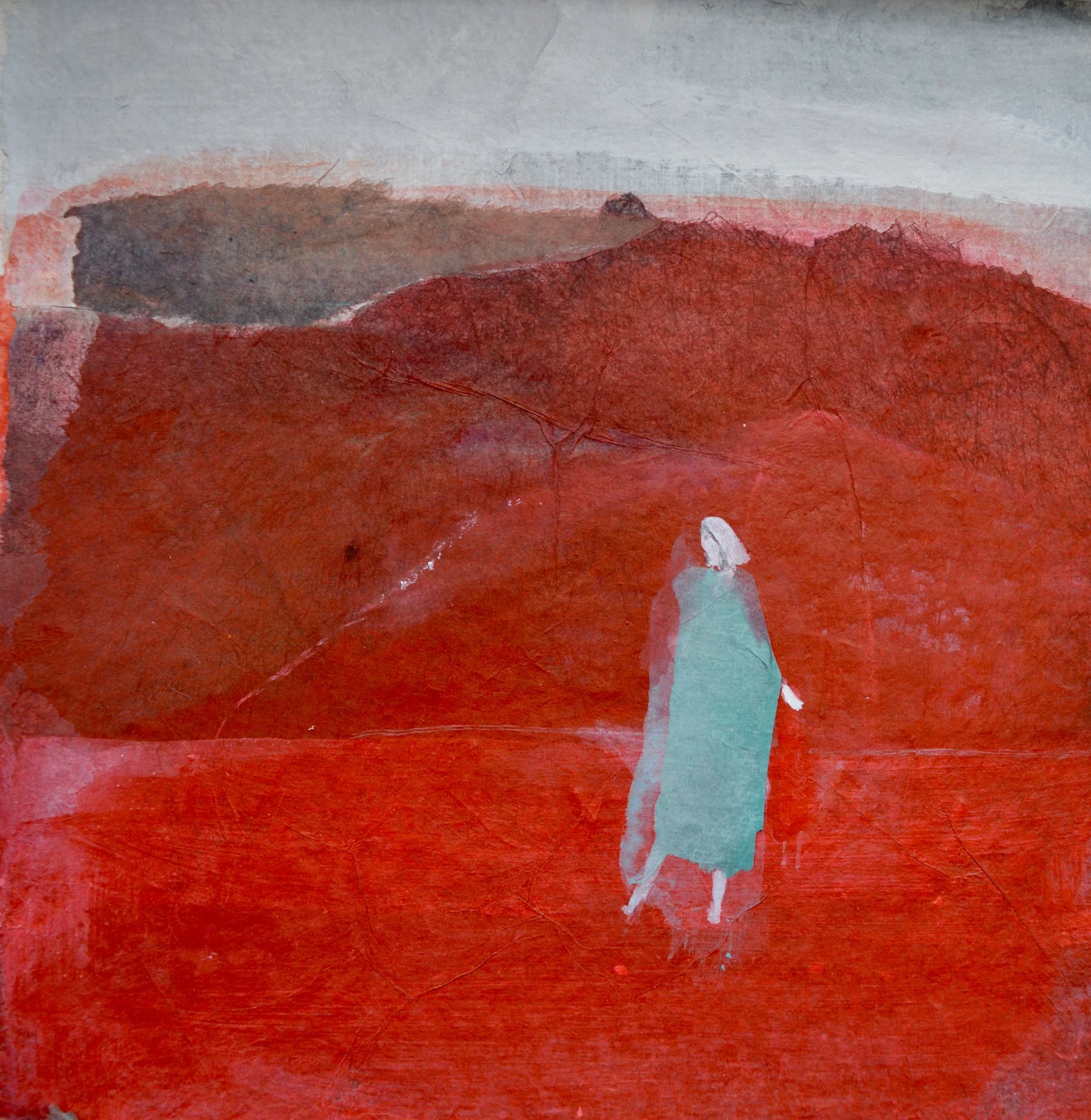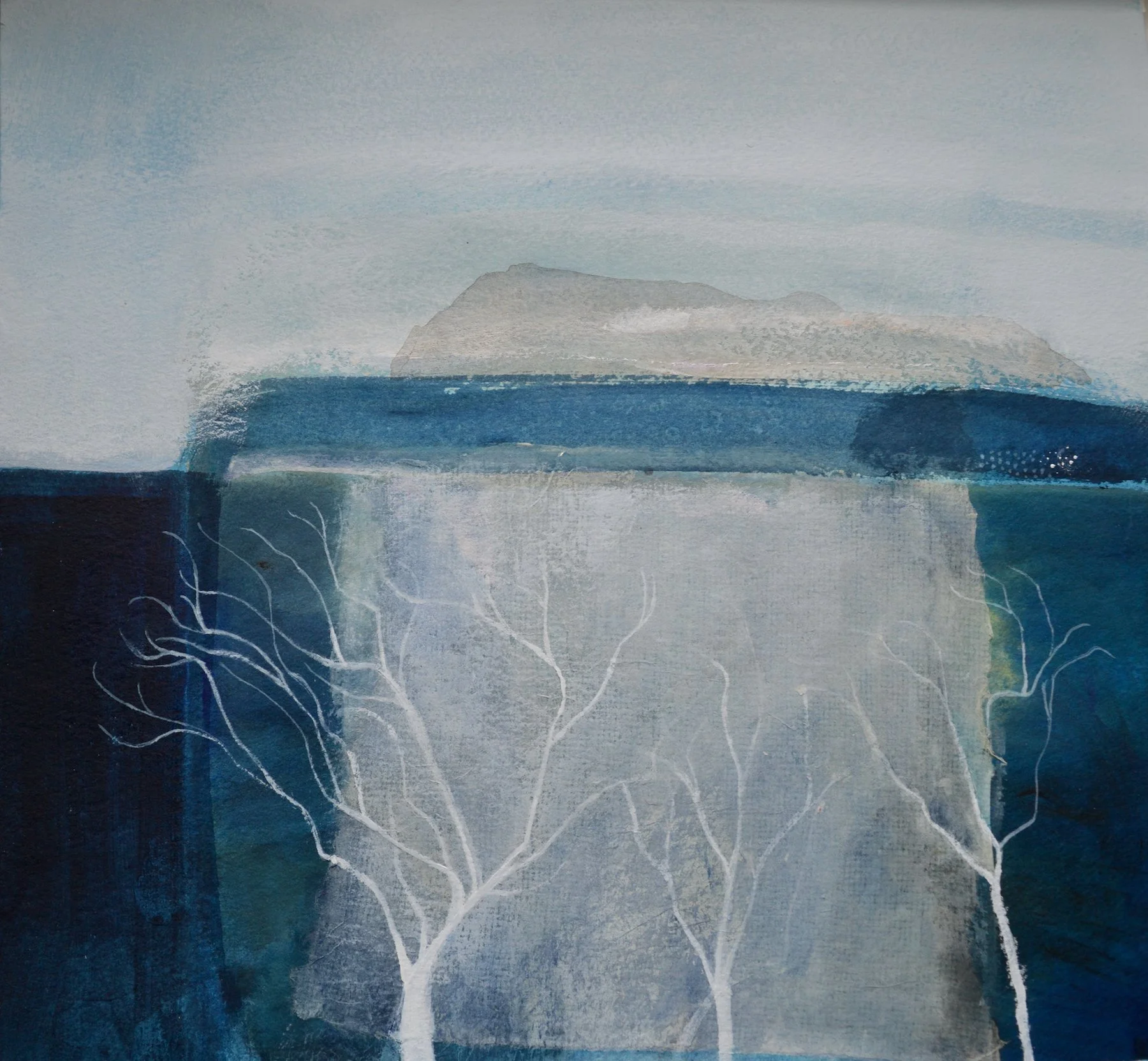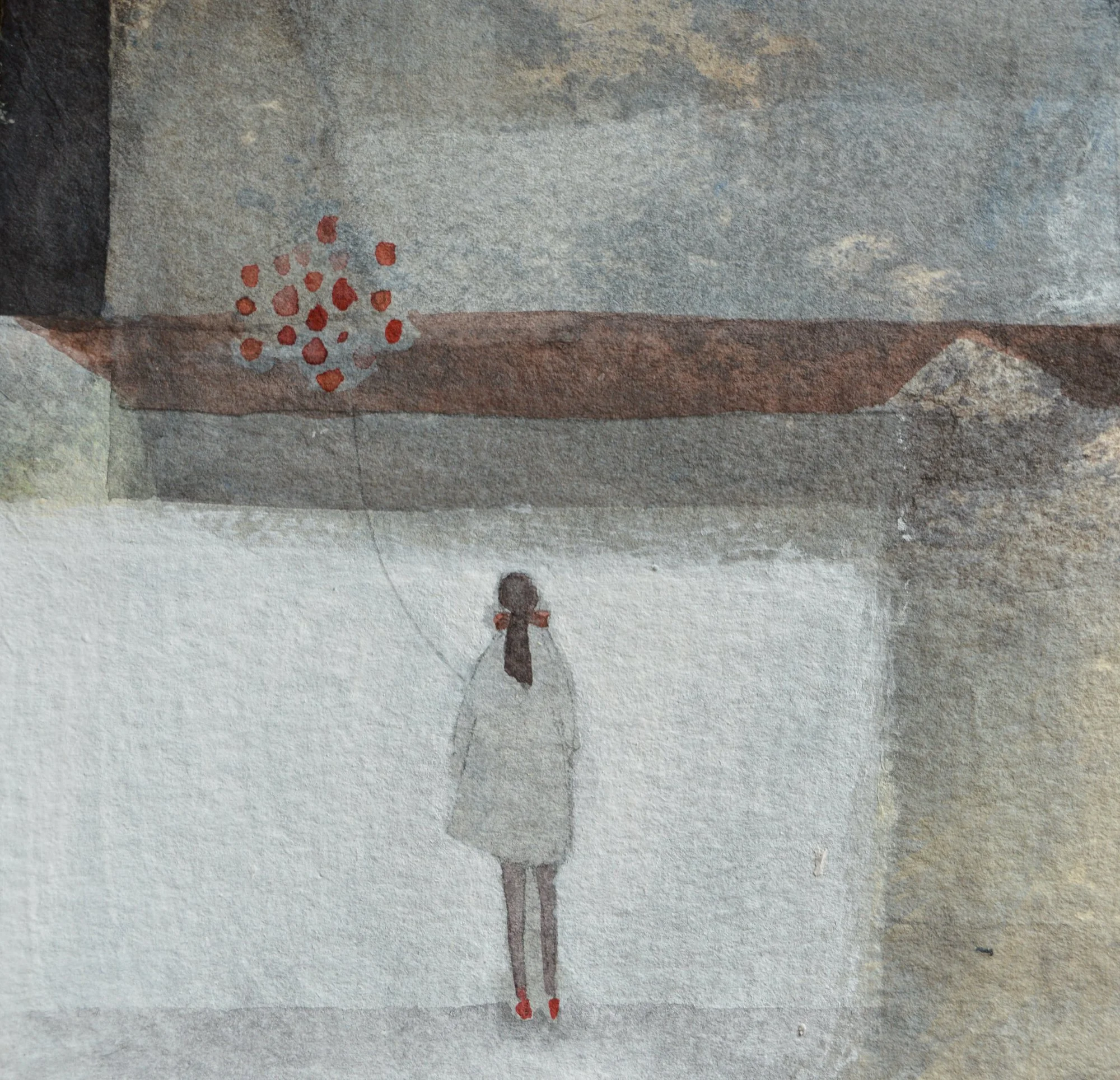ARTIST INTERVIEW: JULIE COLLINS
Please introduce yourself. You have said previously you ‘ran away’ from the Isle of Man to pursue your dream of becoming an artist. What initially sparked your interest in art?
My family were very creative and included my Grandpa who was an architect, my uncle a journalist, clockmakers, barometer designers, picture-framers, and entrepreneurs. My grandmother was a tailoress who made elaborate vestments without using any patterns, for the priests from the Catholic church. Had she been born in different circumstances I am sure she could have been a fantastic fashion designer. I spent a lot of time at her house watching her working in beautiful fabrics. I remember the shapes of the cloth being laid out and marked up vey precisely. My first school was a Convent and my friend Mary, and I were obsessed with drawing. We drew every national costume in felt tip pens and would meet up every weekend to make art. At the Convent we weren’t allowed to paint in case we messed up our uniforms.
Then at secondary school I had a wonderful teacher who, if you had the talent, encouraged you to go to Art school in the UK. This meant many extra hours after school, in the Art room, drawing, painting and sculpting a head from life. At age 14, our teacher Miss Davie, introduced us to abstract art and we learnt a lot of art history even though it wasn’t on the curriculum.
Where do you feel most inspired?
I feel inspired in various places. This includes visiting Art Galleries and Museums. Recently, I saw a fabulous Elisabeth Frink Exhibition at the Dorchester Museum & Art Gallery. I am deeply moved by her work and the exhibition included previously unseen drawings and sculpture. She described herself as a humanist and was concerned with humanity rather than politics in art. I relate to this myself and it features in my work in a different form.
Earlier this year I visited Egypt and was lucky enough to see ancient Sculptures and wonderful paintings in the tombs in Luxor. Seeing ancient Art is both humbling and hugely inspiring.
I am also inspired by ‘being’ in the landscape, not only at the view, but being out in the open gives me space and time to create new ideas and freshen my approach.
What drew you to your chosen medium of watercolour? How does your medium reflect the narrative of your work?
In 1984, I bought my first watercolour box from Cass Art. Previously I had been painting in acrylic and oil. Using watercolour was liberating in that I loved the way it flowed and if you are brave enough, it creates amazing effects. This is a great contrast to the way acrylic and oil sit where you put it.
Then I saw Helen Frankenthaler’s work which is free, lively and brave. She worked on a grand scale and this inspired me to have the confidence to paint on whole sheets of watercolour paper – up to 2.64 x 1.93 metres. This medium is perfect for the narrative of my work as I am able to work freely in many layers. This gives an interesting depth and history to each piece.
At Art School during the early 1980’s I was taught by Abstract Expressionist painters including Mali Morris RA, Sir Terry Frost and Albert Irvin RA. This influenced the way I like to work freely in paint and find I work more naturally with water-based paints.
In one of your artist talks, you explained how you are most interested in conveying ‘honesty’ in your paintings. How do you do this through your practise? How does your work reflect you as an individual?
When I set out to paint my most successful work, it is brought about freely. What I mean by this is if I start out with a very set idea of exactly how the painting will be when it’s finished, it never works.
Having learnt a great deal about colour, drawing, composition and how paint behaves, I am able to take risks and then allow the work to evolve. The honesty is conveyed by working through my heart and trusting my instincts. I only use my head to plan colours and assess the composition, tone and balance in each painting. My personality is fairly free, and I am myself when I go with the flow. This is entirely reflected in my artwork.
Describe your creative process. Tell me about your process from start to finish of one of your works.
I generally work in a series. This often means that the series will be a particular colour palette. My framer will always exclaim about this! Each piece in the series helps to inform the others, almost like a faithful and supportive family. Depending on how I am feeling will dictate the scale of the work. If I am feeling very brave or want to push myself out of my comfort zone, I will work very large. The first step is to get rid of most of the white paper. This begins by careful mixing all of the colours I intend to use. It then entails working quickly on the floor and crawling around the paper armed with several pots of paint and various large brushes. This is the most exciting part of my process, apart from when I manage to successfully complete a painting.
The next stage is always the most difficult, where I will strengthen the composition and add several other layers of paint. This stage can make or break the piece. It usually takes rather a long time and can’t be rushed. It isn’t possible to describe the exact process of one of my works from start to finish as it is so complex. Some of the time I am working subconsciously, where I can’t remember how I did something. It is impossible for me to replicate anything, as it is another time and there is an entirely different mood or idea.
The last stage will include adding any figures, trees, flowers or birds and highlighting any detail. It is a great moment when I know that I can stand back and leave it alone.
I also work in my sketch book developing ideas or simply painting and drawing for the sake of it. I find sketchbook work extremely liberating and always work very freely in them.
As well as painting landscapes, you also paint abstract figures. Are these figures inspired by people you have seen or your imagination?
The figures in my work are people I have seen walking, standing, lying and sitting on the cliff top or the beach where I live, or figures dancing or moving in an interesting way at a theatre or special drawing event. There is an element of imagination in each figure in my paintings as they are not painted directly from life. I draw regularly from the figure, but these drawings aren’t necessarily used for my paintings.
What does a typical day look like for you as an artist?
I am at my best in the morning and will get most of my work done earlier in the day. Typically, I’ll go up to my studio early in the morning and sit down to assess where I’m at. My studio is my private place where I can sit and stare out of the window and enjoy the peace.
I will then begin work on the paintings that I am drawn to or start some new work. I will stop for lunch for a short time and then carry on until I begin to feel tired. When I’m tired, I will make mistakes and ruin good work. In the evening I will often go out to a yoga class, a walk, the cinema or enjoy a good meal.
Who is your greatest artist inspiration? If you could ask them one question, what would it be?
I have several greatest artist inspirations, which includes Klee, Frankenthaler, Frink, Hockney and Caravaggio. My one question would be to Caravaggio, and I’d ask him to tell me in detail what life was like in Italy when he was alive.
Why do you think art is important in society?
Art and all creative subjects are incredibly important in society. Being educated creatively effects everything and broadens the mind. Access to Museums and Art Galleries is wonderful. We are incredibly lucky in the UK to have so many Art Galleries and Museums that we can visit for free. This is good for education but also makes for an enrichened life and country.













